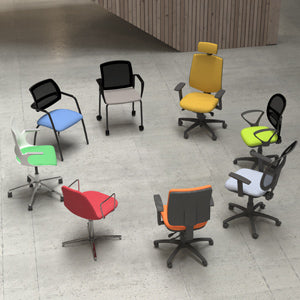Beautiful office layout - get in contact for free office space planning and unique furniture manufacturing that will speak for itself.
Share
Designing an office layout involves considering various factors to create a conducive and efficient work environment. Here are five key factors to keep in mind:

Functionality and Workflow:
- Task Requirements: Understand the nature of tasks performed by different teams or individuals within the office. Ensure that the layout supports their specific needs.
- Workflow Optimization: Design the layout to facilitate a smooth workflow. Consider how employees move through the space and arrange workstations accordingly to minimize disruptions.
Collaboration and Communication:
- Open Spaces vs. Private Areas: Strike a balance between open collaborative spaces and private areas for focused work. Depending on the nature of the work, some teams may require more privacy, while others may benefit from an open and collaborative environment.
- Meeting Spaces: Allocate appropriate areas for meetings, both formal and informal. This could include conference rooms, huddle spaces, and comfortable collaboration zones.
Comfort and Well-being:
- Ergonomics: Prioritize ergonomic furniture and design to enhance employee comfort and reduce the risk of work-related injuries. Consider adjustable desks and chairs to accommodate various preferences and needs.
- Lighting and Ventilation: Ensure that the office space has ample natural light and proper ventilation. Good lighting and air quality contribute to the overall well-being and productivity of employees.
Flexibility and Adaptability:
- Modular Furniture: Choose furniture and layouts that are easily reconfigurable to adapt to changing needs. This allows for flexibility in accommodating growth or changes in work processes.
- Technology Integration: Plan for the integration of technology, such as movable partitions, smart furniture, and adaptable workstations, to accommodate the evolving technological needs of the organization.
Brand Image and Culture:
- Reflect Company Values: The office layout should reflect the company’s values and culture. Consider incorporating branding elements, colors, and design aesthetics that align with the organization’s identity.
- Employee Input: Seek input from employees to understand their preferences and needs. Involving employees in the design process can contribute to a sense of ownership and satisfaction with the workspace.
By carefully considering these factors, you can create an office layout that promotes productivity, collaboration, and employee well-being, ultimately contributing to the overall success of the organisation.

















